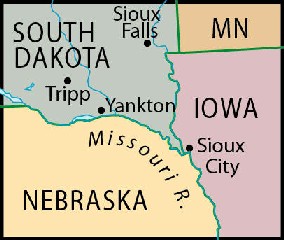The first Amish to settle in South Dakota arrived in April 2010 when three families moved to rural Hutchinson County, near Tripp, in the southeastern part of the state. Two more families have arrived since then and a sixth family is expected in August, when they should have 50 people living on the farms they are buying.
 These families decided that things were getting too crowded in Wisconsin, where they came from, so they found farmland for sale to the west and decided to move. Most are not related to another new Amish community that has been established just over the state line to the south, in Nebraska. The new Nebraska Amish moved west from Michigan.
These families decided that things were getting too crowded in Wisconsin, where they came from, so they found farmland for sale to the west and decided to move. Most are not related to another new Amish community that has been established just over the state line to the south, in Nebraska. The new Nebraska Amish moved west from Michigan.
The Amish families are receiving a warm welcome from their non-Amish neighbors. Phyllis Dewald, a rural resident of the county, told the Yankton Press on Saturday that while they do not live right next to the Amish, they consider them to be neighbors, a warm sentiment that is obviously reciprocated. She said that she admired the beauty of the horses that the Amish use for farm work and that pull their buggies into town for errands and shopping.
The obvious hostility that the Amish back east in Wisconsin appear to foster in some of the residents of Viroqua, in that state, according to a recent news account, does not seem to be a factor in South Dakota. At least not yet. Perhaps when the first Amish horse has the bad judgment to leave a mess in front of someone’s yard, sentiments will change.
Ms. Dewald said that she admires the green thumb of one of the Amish women, Ida Borntreger, who “grows really great asparagus.” Ida has been selling her baked goods to neighbors in bake sales which have prompted envy in Ms. Dewald, who wonders how she can bake so well without electric refrigeration or an electric range. Another Amish woman, Mary Borntreger, explains to the Press that Ida uses a wood stove in a separate room, and she bakes a lot of pies, rolls, and loaves of bread at the same time. Like the other Amish, Ida uses the basement of her house to keep things cool, and they plan to build an ice house for refrigeration.
Mary emphasized to the reporter that their welcome from the neighbors has been very warm. “People want to get acquainted, and they just stop in,” she said. “We have found people to be very helpful and friendly.”
The lengthy newspaper story is clearly written for people who do not have much first-hand experience with the Amish. The first thing the article cleared up for South Dakota readers is that the Amish do not have the same beliefs as the Mennonites or the Hutterites, who are already well established in the same county. The Amish live close to one another, on nearby farms, but they are not a communal society as the Hutterites are.
The Tripp-Delmont school district offers modern school rooms, and the Hutterites have a school. The Amish, however, plan to build their own school for their children as soon as they can. The article points out many features of Amish life, such as their lack of telephones, cars, and electricity.
They shop in Tripp, visit the dentist in town, and do their banking in the community. They buy their livestock at a sale barn in Tripp and butcher their own meat. The reporter was impressed by the fact that the Amish men and boys worked in the barn in the blasting heat, without showing any discomfort. “It’s not too bad. I’ve seen worse,” Dan Borntreger said happily.
He was modest about the quality of the barn he and his associates were building, but he took pride in the fact that they were getting the work done. He did not seem to feel that his work was long, or particularly hard. Instead, he said he felt a sense of freedom while he was working. “We can quit any time we want, we can start any time we want. And we take Sundays off,” he said.
Dan found the county to be very welcoming—he feels a common bond with the neighbors, with their German and German-Russian heritages. He joked, in his own German accent, “they speak quite a bit of German around here. Do you?”
The reporter evidently asked Mary Borntreger what they would do in the winter when the snow storms hit—how would they travel about in their small, horse-drawn buggies. “We will close up the buggy when we have winter or a storm front,” Mary replied. Questions and answers that might seem simplistic to readers familiar with Amish ways were probably quite enlightening to local people who had only a limited exposure to their society and culture.
Ms. Borntreger explained to the reporter that the Amish shun modern conveniences—it is part of their beliefs. “We stay away from modernism,” she added. She said that avoiding modern devices means simply living the way people used to live. The welcoming tone of the newspaper article, and the apparent enthusiasm from the local people, contrasts with the experiences of some Amish moving into new areas, where their ways are misunderstood. Examples from Clarion County, Pennsylvania, last year of official persecutions of Amish who had newly settled in the county—particularly in January, March, May, June, October, and December 2009—provide a striking contrast to the supportive attitudes of the people in South Dakota.